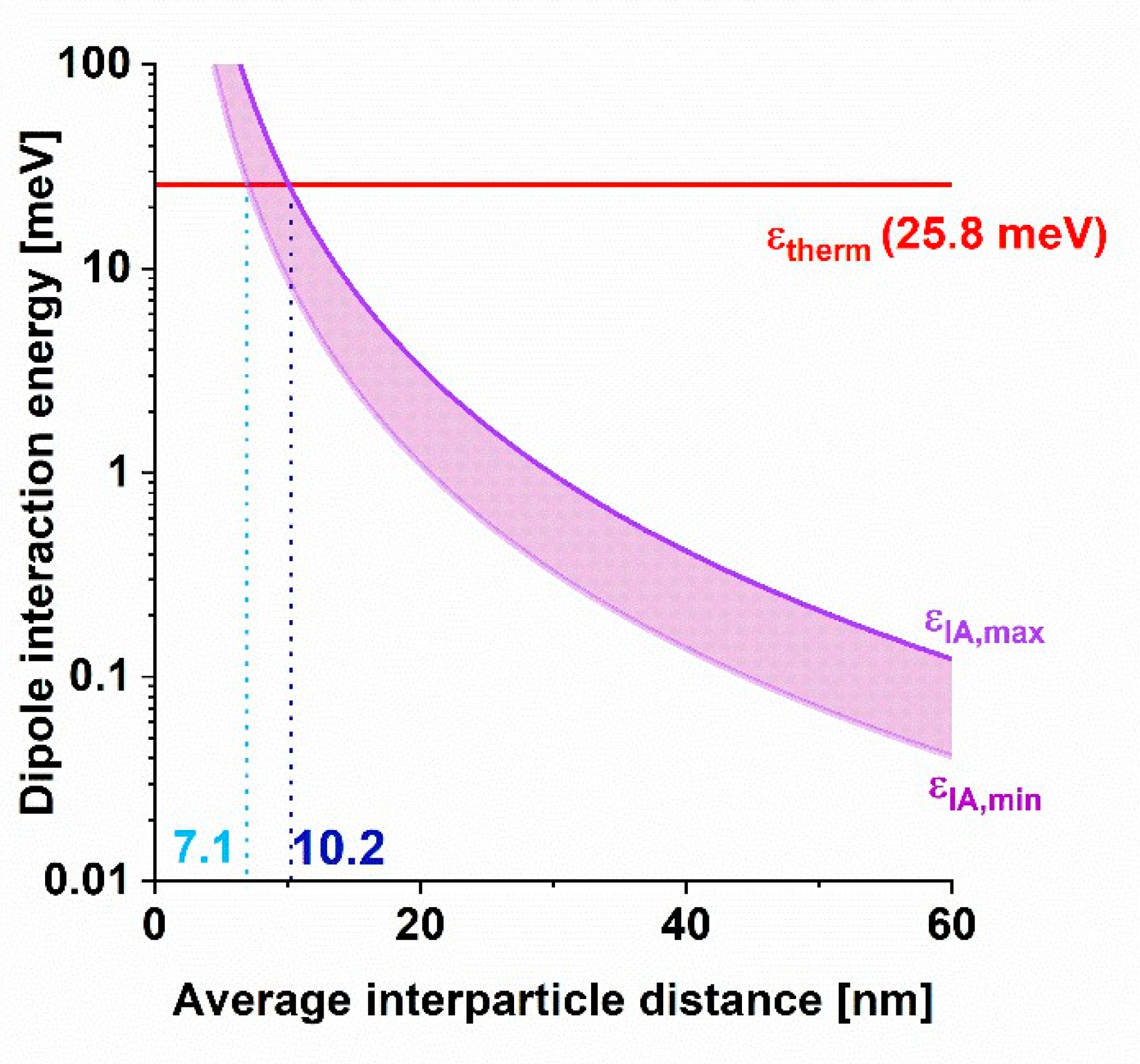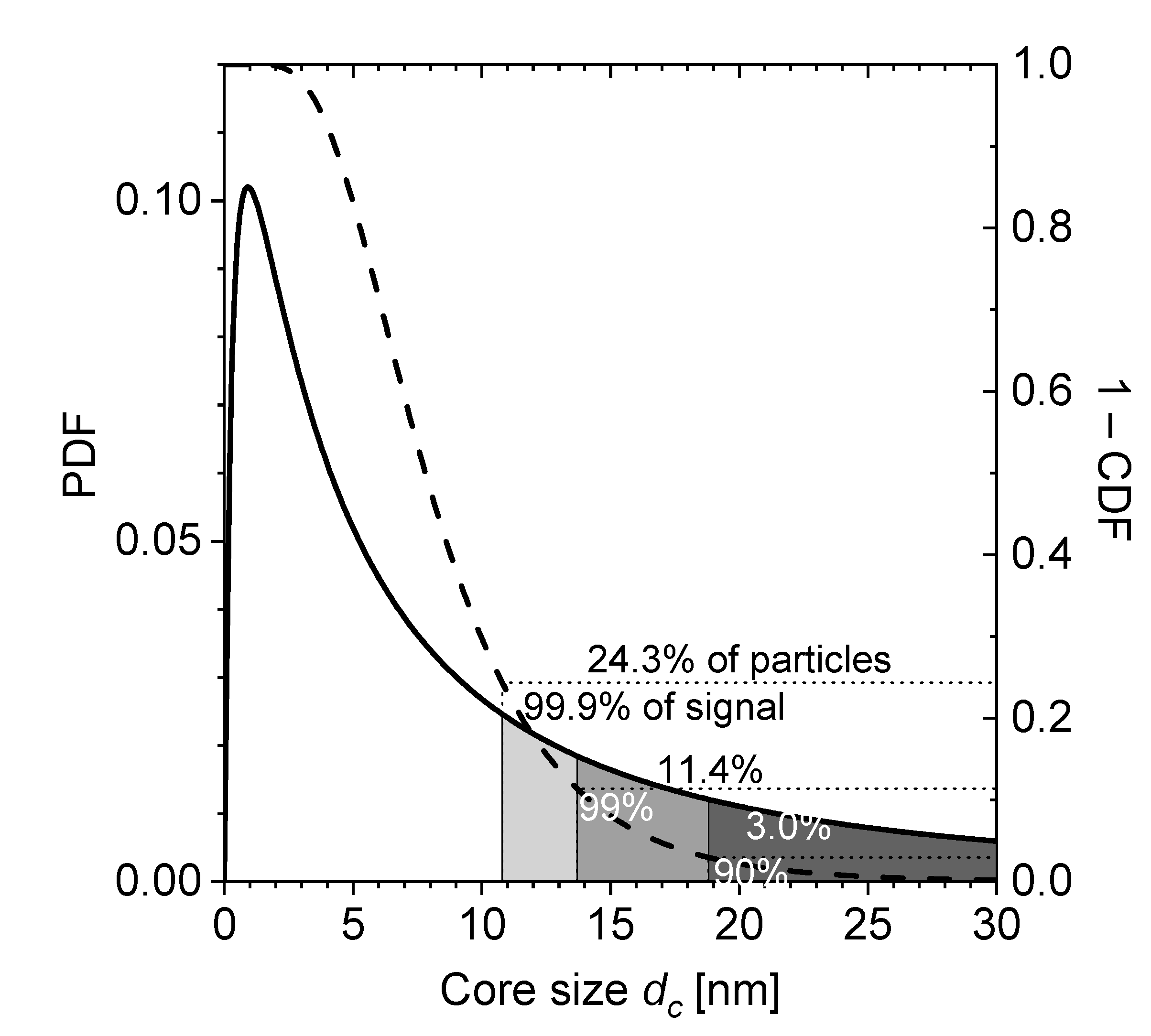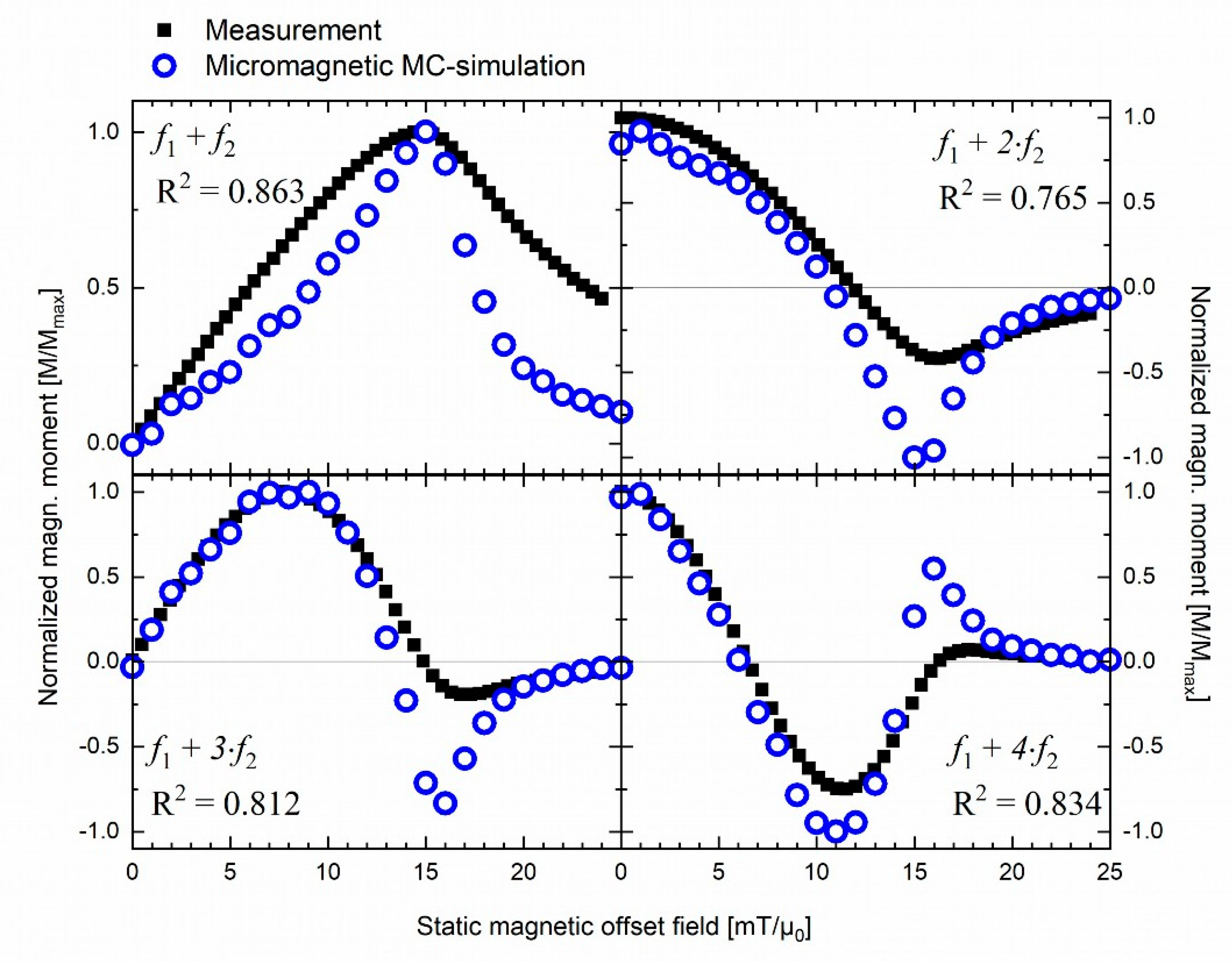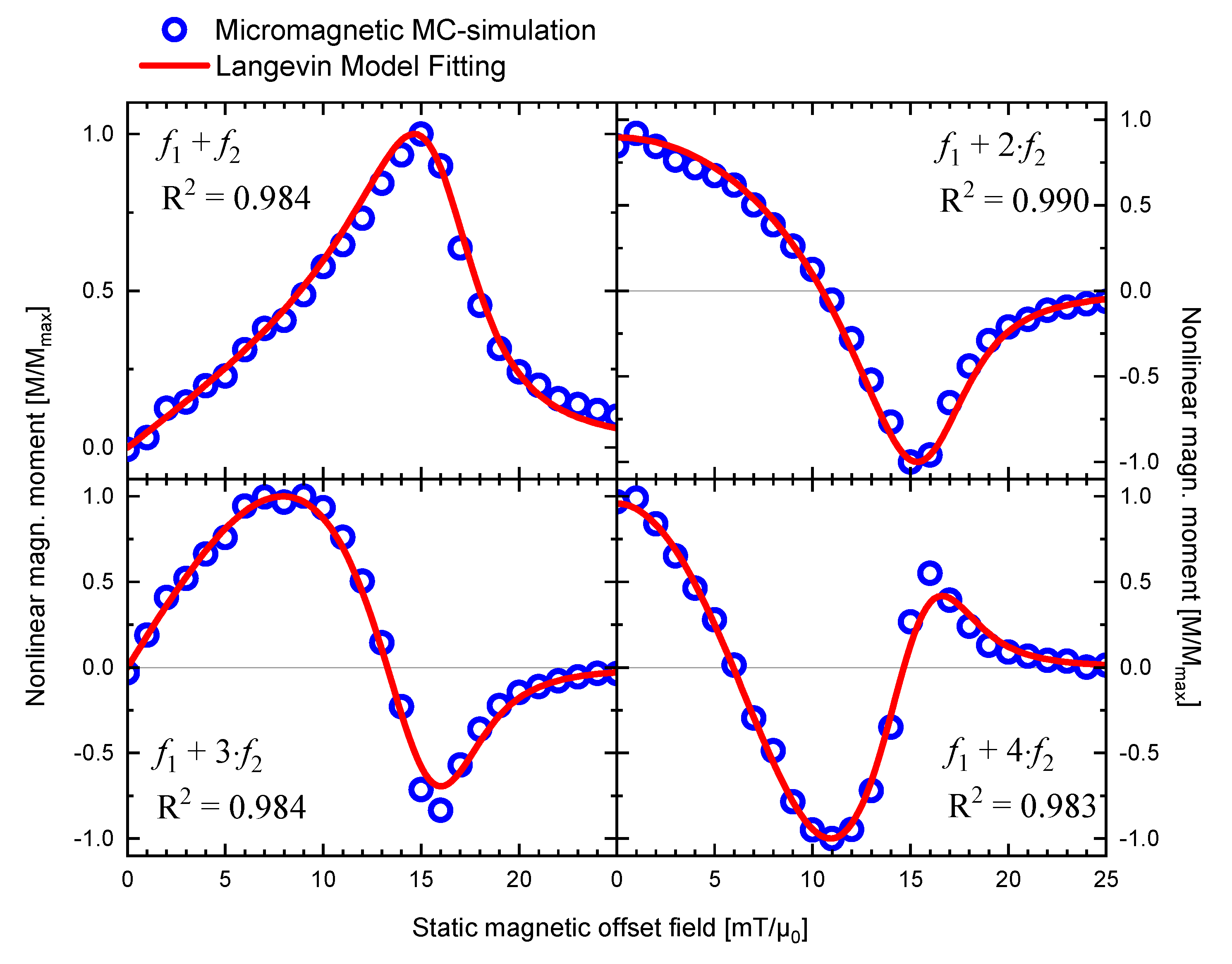Comparative Modeling of Frequency Mixing Measurements of Magnetic Nanoparticles Using Micromagnetic Simulations and Langevin Theory
Abstract
:1. Introduction
2. Materials and Methods
2.1. Experimental Setup for Frequency Mixing Magnetic Detection
2.2. Thermodynamic Langevin Model of a Magnetic Nanoparticle Ensemble
2.3. Micromagnetic Monte Carlo (MC-)Simulation
3. Results
3.1. Experimental Results and Thermodynamic Langevin Model Fitting
3.2. Micromagnetic MC-Simulation Results
3.3. Comparing Micromagnetic MC-Simulation Results and Thermodynamic Langevin Model Fitting
4. Discussion
5. Conclusions
- MC-simulations allow the investigation of the dynamic hysteresis (M(H))-loop during AMF excitation, revealing a minor opening (cf. Figure 2). This opening is attributed to the small portion of large, thermally blocked particles.
- Langevin model fitting suggests that 90% of the experimentally detected FMMD signal intensity is generated by the largest 10% of the particles (cf. Figure 5).
- For the large particles ( nm) which dominate the FMMD signal, relaxation cannot be neglected. However, this effect is not included in our Langevin model. We suspect this is the reason for observed deviations between the Langevin model and MC-simulations.
- Complementary experimental methods should be used to derive MNP properties for more accurate input in the MC-simulations (to address and remedy point 1, above). From this, we also plan to further increase our predictive accuracy in the future by coordinating simulation and experimental parameters to be identical (both materials properties and field parameters).
- Experimental sample preparation should be expanded to allow—ideally gradually controllable—Brownian rotation of MNPs (e.g., in poly-acrylamide gels) in order to precisely analyze the role of the Brownian relaxation mechanism for signal generation (see also next point below).
- Furthermore, MC-simulations could be expanded by including magnetic particle–particle interaction effects and the inclusion of clustering-effects of MNPs. This should be investigated with special regard to point 3 (above), because magnetic interaction scales with increasing particle core size. Additionally, the influence of effective anisotropy could be studied systematically with MC-simulations. Finally, the dominant relaxation mechanism in dual frequency excitation could be further investigated by weighting Néel and Brownian relaxation mechanisms systematically in MC-simulations, and comparing the results to experimental findings.
- Point 4 (above) suggests the necessity for multi-theory approaches to interpret dual-frequency MNP excitation responses. Therefore, systematic parameter studies, e.g., varying MNP properties such as effective anisotropy, median core sizes and shell sizes, and AMF parameters ( , , ), should be performed to generate a multi-parameter repository from MC-simulations. This could serve as a basis for a unified model to explain FMMD signal generation in the future. However, such a study must be well designed to ensure acceptable computational effort.
Author Contributions
Funding
Data Availability Statement
Acknowledgments
Conflicts of Interest
Appendix A. Estimating the Effect of Magnetic Dipole–Dipole Interaction Energy

Appendix B. Log-Normal Distribution Probability Density Function (PDF)

References
- Thanh, N.T.K. Magnetic Nanoparticles: From Fabrication to Clinical Applications; CRC Press: Boca Raton, FL, USA, 2012. [Google Scholar]
- Krishnan, K.M. Biomedical nanomagnetics: A spin through possibilities in imaging, diagnostics, and therapy. IEEE Trans. Magn. 2010, 46, 2523–2558. [Google Scholar] [CrossRef] [PubMed] [Green Version]
- Kriz, K.; Gehrke, J.; Kriz, D. Advancements toward magneto immunoassays. Biosens. Bioelectron. 1998, 13, 817–823. [Google Scholar] [CrossRef]
- Lange, J.; Kötitz, R.; Haller, A.; Trahms, L.; Semmler, W.; Weitschies, W. Magnetorelaxometry—A new binding specific detection method based on magnetic nanoparticles. J. Magn. Magn. Mater. 2002, 252, 381–383. [Google Scholar] [CrossRef]
- Krause, H.-J.; Wolters, N.; Zhang, Y.; Offenhäusser, A.; Miethe, P.; Meyer, M.H.F.; Hartmann, M.; Keusgen, M. Magnetic particle detection by frequency mixing for immunoassay applications. J. Magn. Magn. Mater. 2007, 311, 436–444. [Google Scholar] [CrossRef]
- Cardoso, S.; Leitao, D.C.; Dias, T.M.; Valadeiro, J.; Silva, M.D.; Chicharo, A.; Silverio, V.; Gaspar, J.; Freitas, P.P. Challenges and trends in magnetic sensor integration with microfluidics for biomedical applications. J. Phys. D Appl. Phys. 2017, 50, 213001. [Google Scholar] [CrossRef]
- Wu, K.; Saha, R.; Su, D.; Krishna, V.D.; Liu, J.; Cheeran, M.C.-J.; Wang, J.-P. Magnetic-nanosensor-based virus and pathogen detection strategies before and during covid-19. ACS Appl. Nano Mater. 2020, 3, 9560–9580. [Google Scholar] [CrossRef]
- Pietschmann, J.; Dittmann, D.; Spiegel, H.; Krause, H.-J.; Schröper, F. A Novel Method for Antibiotic Detection in Milk Based on Competitive Magnetic Immunodetection. Foods 2020, 9, 1773. [Google Scholar] [CrossRef] [PubMed]
- Achtsnicht, S.; Neuendorf, C.; Faßbender, T.; Nölke, G.; Offenhäusser, A.; Krause, H.-J.; Schröper, F. Sensitive and rapid detection of cholera toxin subunit B using magnetic frequency mixing detection. PLoS ONE 2019, 14, e0219356. [Google Scholar] [CrossRef]
- Lenglet, L. Multiparametric magnetic immunoassays utilizing non-linear signatures of magnetic labels. J. Magn. Magn. Mater. 2009, 321, 1639–1643. [Google Scholar] [CrossRef]
- Tu, L.; Wu, K.; Klein, T.; Wang, J.-P. Magnetic nanoparticles colourization by a mixing-frequency method. J. Phys. D Appl. Phys. 2014, 47, 155001. [Google Scholar] [CrossRef]
- Achtsnicht, S.; Pourshahidi, A.M.; Offenhäusser, A.; Krause, H.-J. Multiplex Detection of Different Magnetic Beads Using Frequency Scanning in Magnetic Frequency Mixing Technique. Sensors 2019, 19, 2599. [Google Scholar] [CrossRef] [Green Version]
- Shasha, C.; Krishnan, K.M. Nonequilibrium Dynamics of Magnetic Nanoparticles with Applications in Biomedicine. Adv. Mater. 2020, e1904131. [Google Scholar] [CrossRef]
- Hong, H.; Lim, E.-G.; Jeong, J.-C.; Chang, J.; Shin, S.-W.; Krause, H.-J. Frequency Mixing Magnetic Detection Scanner for Imaging Magnetic Particles in Planar Samples. J. Vis. Exp. 2016. [Google Scholar] [CrossRef]
- Achtsnicht, S. Multiplex Magnetic Detection of Superparamagnetic Beads for the Identification of Contaminations in Drinking Water. Ph.D. Thesis, RWTH Aachen University, Aachen, Germany, 2020. [Google Scholar]
- Krishnan, K.M. Fundamentals and Applications of Magnetic Materials; Oxford University Press: Oxford, UK, 2016; ISBN 0199570442. [Google Scholar]
- Gubin, S.P. Magnetic Nanoparticles; WILEY-VCH Verlag GmbH & Co.: Weinheim, Germany, 2009. [Google Scholar]
- Gilbert, T.L. Classics in Magnetics A Phenomenological Theory of Damping in Ferromagnetic Materials. IEEE Trans. Magn. 2004, 40, 3443–3449. [Google Scholar] [CrossRef]
- Usov, N.A.; Liubimov, B.Y. Dynamics of magnetic nanoparticle in a viscous liquid: Application to magnetic nanoparticle hyperthermia. J. Appl. Phys. 2012, 112, 23901. [Google Scholar] [CrossRef]
- Engelmann, U.M. Assessing Magnetic Fluid Hyperthermia: Magnetic Relaxation Simulation, Modeling of Nanoparticle Uptake inside Pancreatic Tumor Cells and In Vitro Efficacy, 1st ed.; Infinite Science Publication: Lübeck, Germany, 2019; ISBN 978-3945954584. [Google Scholar]
- Shasha, C. Nonequilibrium Nanoparticle Dynamics for the Development of Magnetic Particle Imaging. Ph.D. Thesis, University of Washington, Seattle, WA, USA, 2019. [Google Scholar]
- Engelmann, U.M.; Shasha, C.; Slabu, I. Magnetic Nanoparticle Relaxation in Biomedical Application: Focus on Simulating Nanoparticle Heating. In Magnetic Nanoparticles in Human Health and Medicine: Current Medical Applications and Alternative Therapy of Cancer; in press; John Wiley & Sons, Inc.: Hoboken, NJ, USA, 2021; ISBN 978-1119754671. [Google Scholar]
- Shah, S.A.; Reeves, D.B.; Ferguson, R.M.; Weaver, J.B.; Krishnan, K.M. Mixed Brownian alignment and Néel rotations in superparamagnetic iron oxide nanoparticle suspensions driven by an ac field. Phys. Rev. B 2015, 92, 94438. [Google Scholar] [CrossRef] [Green Version]
- Aali, H.; Mollazadeh, S.; Khaki, J.V. Single-phase magnetite with high saturation magnetization synthesized via modified solution combustion synthesis procedure. Ceram. Int. 2018, 44, 20267–20274. [Google Scholar] [CrossRef]
- Darton, N.J.; Ionescu, A.; Llandro, J. Magnetic Nanoparticles in Biosensing and Medicine; Cambridge University Press: Cambridge, UK, 2019; ISBN 1107031095. [Google Scholar]
- Yu, E.Y.; Bishop, M.; Zheng, B.; Ferguson, R.M.; Khandhar, A.P.; Kemp, S.J.; Krishnan, K.M.; Goodwill, P.W.; Conolly, S.M. Magnetic particle imaging: A novel in vivo imaging platform for cancer detection. Nano Lett. 2017, 17, 1648–1654. [Google Scholar] [CrossRef]
- Soto-Aquino, D.; Rinaldi, C. Nonlinear energy dissipation of magnetic nanoparticles in oscillating magnetic fields. J. Magn. Magn. Mater. 2015, 393, 46–55. [Google Scholar] [CrossRef]
- Grüttner, C.; Teller, J.; Schütt, W.; Westphal, F.; Schümichen, C.; Paulke, B.R. Preparation and Characterization of Magnetic Nanospheres for in Vivo Application. In Scientific and Clinical Applications of Magnetic Carriers; Häfeli, U., Schütt, W., Teller, J., Zborowski, M., Eds.; Springer: Boston, MA, USA, 1997; ISBN 978-1-4757-6482-6_4. [Google Scholar]
- Kallumadil, M.; Tada, M.; Nakagawa, T.; Abe, M.; Southern, P.; Pankhurst, Q.A. Suitability of commercial colloids for magnetic hyperthermia. J. Magn. Magn. Mater. 2009, 321, 1509–1513. [Google Scholar] [CrossRef]
- Yoshida, T.; Enpuku, K. Simulation and Quantitative Clarification of AC Susceptibility of Magnetic Fluid in Nonlinear Brownian Relaxation Region. Jpn. J. Appl. Phys. 2009, 48, 127002. [Google Scholar] [CrossRef]
- Ludwig, F.; Remmer, H.; Kuhlmann, C.; Wawrzik, T.; Arami, H.; Ferguson, R.M.; Krishnan, K.M. Self-consistent magnetic properties of magnetite tracers optimized for magnetic particle imaging measured by ac susceptometry, magnetorelaxometry and magnetic particle spectroscopy. J. Magn. Magn. Mater. 2014, 360, 169–173. [Google Scholar] [CrossRef] [PubMed] [Green Version]
- Engelmann, U.M.; Shasha, C.; Teeman, E.; Slabu, I.; Krishnan, K.M. Predicting size-dependent heating efficiency of magnetic nanoparticles from experiment and stochastic Néel-Brown Langevin simulation. J. Magn. Magn. Mater. 2019, 471, 450–456. [Google Scholar] [CrossRef]
- Tay, Z.W.; Hensley, D.W.; Vreeland, E.C.; Zheng, B.; Conolly, S.M. The relaxation wall: Experimental limits to improving MPI spatial resolution by increasing nanoparticle core size. Biomed. Phys. Eng. Express 2017, 3, 35003. [Google Scholar] [CrossRef] [PubMed]
- Shasha, C.; Teeman, E.; Krishnan, K.M. Nanoparticle core size optimization for magnetic particle imaging. Biomed. Phys. Eng. Express 2019, 5, 55010. [Google Scholar] [CrossRef]
- Tong, S.; Quinto, C.A.; Zhang, L.; Mohindra, P.; Bao, G. Size-dependent heating of magnetic iron oxide nanoparticles. ACS Nano 2017, 11, 6808–6816. [Google Scholar] [CrossRef]
- Engelmann, U.M.; Seifert, J.; Mues, B.; Roitsch, S.; Ménager, C.; Schmidt, A.M.; Slabu, I. Heating efficiency of magnetic nanoparticles decreases with gradual immobilization in hydrogels. J. Magn. Magn. Mater. 2019, 471, 486–494. [Google Scholar] [CrossRef]
- Dennis, C.L.; Krycka, K.L.; Borchers, J.A.; Desautels, R.D.; van Lierop, J.; Huls, N.F.; Jackson, A.J.; Gruettner, C.; Ivkov, R. Internal Magnetic Structure of Nanoparticles Dominates Time-Dependent Relaxation Processes in a Magnetic Field. Adv. Funct. Mater. 2015, 25, 4300–4311. [Google Scholar] [CrossRef]
- Engelmann, U.M.; Buhl, E.M.; Draack, S.; Viereck, T.; Ludwig, F.; Schmitz-Rode, T.; Slabu, I. Magnetic relaxation of agglomerated and immobilized iron oxide nanoparticles for hyperthermia and imaging applications. IEEE Magn. Lett. 2018, 9, 1–5. [Google Scholar] [CrossRef]
- Branquinho, L.C.; Carrião, M.S.; Costa, A.S.; Zufelato, N.; Sousa, M.H.; Miotto, R.; Ivkov, R.; Bakuzis, A.F. Effect of magnetic dipolar interactions on nanoparticle heating efficiency: Implications for cancer hyperthermia. Sci. Rep. 2013, 3, 2887. [Google Scholar] [CrossRef] [Green Version]
- Ilg, P.; Kröger, M. Dynamics of interacting magnetic nanoparticles: Effective behavior from competition between Brownian and Néel relaxation. Phys. Chem. Chem. Phys. 2020, 22, 22244–22259. [Google Scholar] [CrossRef]
- Landi, G.T. Role of dipolar interaction in magnetic hyperthermia. Phys. Rev. B 2014, 89, 014403. [Google Scholar] [CrossRef]
- Ilg, P. Equilibrium magnetization and magnetization relaxation of multicore magnetic nanoparticles. Phys. Rev. B 2017, 95, 214427. [Google Scholar] [CrossRef]
- Ficko, B.W.; NDong, C.; Giacometti, P.; Griswold, K.E.; Diamond, S.G. A Feasibility Study of Nonlinear Spectroscopic Measurement of Magnetic Nanoparticles Targeted to Cancer Cells. IEEE Trans. Biomed. Eng. 2017, 64, 972–979. [Google Scholar] [CrossRef] [PubMed] [Green Version]
- Chantrell, R.; Popplewell, J.; Charles, S. Measurements of particle size distribution parameters in ferrofluids. IEEE Trans. Magn. 1978, 14, 975–977. [Google Scholar] [CrossRef]





| Effective Anisotropy Constant | Saturation Magnetization 1 MS | Mass Density of Magnetite | Viscosity of Surrounding (Water) | Temperature |
|---|---|---|---|---|
| 11 kJ/m3 | 476 kA/m | 5.2 g/cm3 | Pas | 300 K |
| Core Diameter | Log-Normal Distribution Width | Polydispersity Index (PDI) | Hydrodynamic Diameter 2 | Concentration 1 |
|---|---|---|---|---|
| 7.81 nm | 0.346 | 0.127 | 20 nm | 2.4 mg(Fe)/mL |
Publisher’s Note: MDPI stays neutral with regard to jurisdictional claims in published maps and institutional affiliations. |
© 2021 by the authors. Licensee MDPI, Basel, Switzerland. This article is an open access article distributed under the terms and conditions of the Creative Commons Attribution (CC BY) license (https://creativecommons.org/licenses/by/4.0/).
Share and Cite
Engelmann, U.M.; Shalaby, A.; Shasha, C.; Krishnan, K.M.; Krause, H.-J. Comparative Modeling of Frequency Mixing Measurements of Magnetic Nanoparticles Using Micromagnetic Simulations and Langevin Theory. Nanomaterials 2021, 11, 1257. https://doi.org/10.3390/nano11051257
Engelmann UM, Shalaby A, Shasha C, Krishnan KM, Krause H-J. Comparative Modeling of Frequency Mixing Measurements of Magnetic Nanoparticles Using Micromagnetic Simulations and Langevin Theory. Nanomaterials. 2021; 11(5):1257. https://doi.org/10.3390/nano11051257
Chicago/Turabian StyleEngelmann, Ulrich M., Ahmed Shalaby, Carolyn Shasha, Kannan M. Krishnan, and Hans-Joachim Krause. 2021. "Comparative Modeling of Frequency Mixing Measurements of Magnetic Nanoparticles Using Micromagnetic Simulations and Langevin Theory" Nanomaterials 11, no. 5: 1257. https://doi.org/10.3390/nano11051257
APA StyleEngelmann, U. M., Shalaby, A., Shasha, C., Krishnan, K. M., & Krause, H.-J. (2021). Comparative Modeling of Frequency Mixing Measurements of Magnetic Nanoparticles Using Micromagnetic Simulations and Langevin Theory. Nanomaterials, 11(5), 1257. https://doi.org/10.3390/nano11051257








